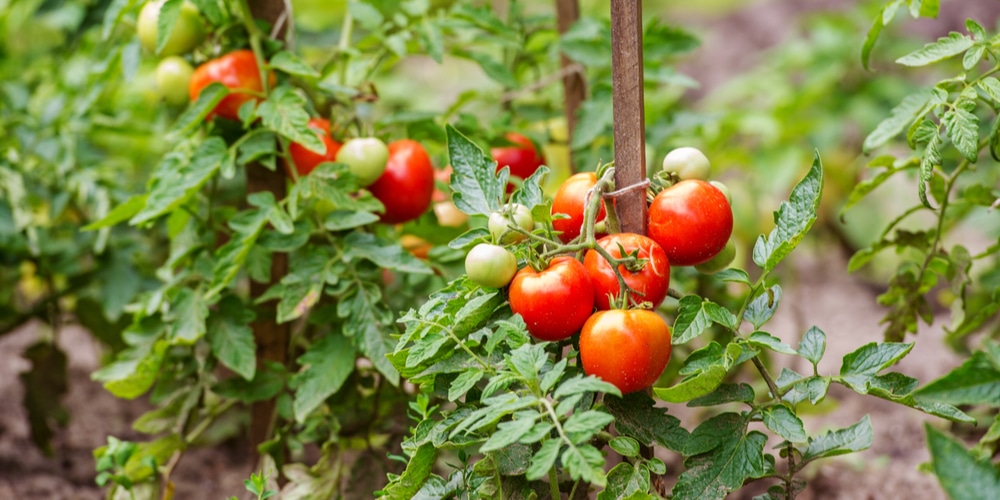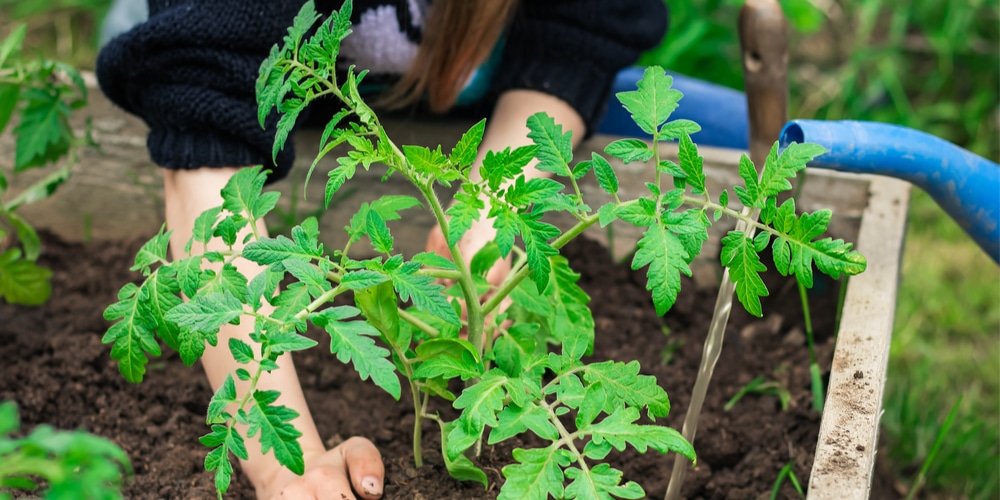Tomatoes generally take between seventy and ninety days to grow and ripen, depending on the variety you decide to grow and the climate where you live. It’s recommended that you plant your tomato seed in the spring at the beginning of the growing season. This will give your plants time to grow and produce a crop of fruit throughout the summer.
Tomatoes are a warm-season crop, are relatively easy to grow, and are tasty and versatile. Let’s look at the best time of year to plant tomatoes to achieve a bountiful harvest.
When is the best time of year to plant tomatoes?

The simple answer is that tomatoes should be planted in the early spring after the last frost. However, to determine the perfect time, you’ll also need to consider factors such as your location and its climate and temperature. The type of tomato plant you plan to grow, how long it will take to mature, and the fruit to ripen.
A tomato plant needs at least three months of warm weather to produce a great crop, as a general rule. It’s, therefore, a good idea to plant your tomatoes in the spring so that they can grow throughout the summer months. You may need to plant your seeds inside before the last frost so that they are ready to go out in your yard when the weather begins to heat up.
When growing tomatoes, you have two choices, you can either plant seeds, or you can buy ready-grown seedlings. If you’re planting seeds, you can grow these indoors in March or April, depending on which state you live in. If you live in USDA hardiness zones eight or nine, you can start growing your tomato seeds indoors as early as mid-January.
Factors that determine the best time of year to plant tomatoes
When deciding when to plant tomatoes, there are many things to consider, such as temperature, variety of seeds, and how long the tomatoes take to grow. You can also consult the seed packet for more advice about when to plant. Here are some things you may like to consider:
Temperature
For tomatoes to establish themselves, thrive, and continue to thrive and produce fruit, the temperature at night shouldn’t fall below 55℉. If you plant seeds outside at a lower temperature, they won’t be able to germinate and sprout.
Don’t move seedlings that have been grown inside, outdoors until temperatures start to rise. Seedlings need to acclimatize before they are moved outside full time and left out at night. You can put your seedlings outside for a couple of hours during the warmest part of the day and bring them inside at night. Don’t leave them outside full time until the night temperature is around 60℉.
As well as air temperature, it’s also a wise idea to think about soil temperature. The best soil temperature for growing tomatoes is 60℉. You can use a soil thermometer to test the temperature of the soil. Some gardeners can tell whether the soil is warm enough or not by sticking their finger about two inches into the ground. This knowledge will come with experience. If the soil feels too cold to keep your finger there for over a minute, then it’s not yet warm enough to grow tomatoes.
Location
Some states are warm year-round and have multiple summer-like growing seasons. For example, many places in California have a growing season that starts in the fall around October and another growing season that begins in January or February.
Exposure to the sun
Tomatoes like to grow in sunny conditions and should be exposed to full sun for at least six hours a day. If you don’t get at least half a day of sun in the spring when you’re planning to plant your tomatoes, it may be best to start the seeds off indoors or wait a couple of weeks until the weather gets better.
Tomato type and variety
There are two types of tomatoes available; determinate tomatoes or indeterminate tomatoes. Each kind also has many different varieties. It’s a good idea to think carefully about which kind you want to grow as the choice will determine the number of tomatoes you’re likely to produce as well as the duration of the harvest. The type of tomatoes you choose will have varying growing requirements, and you’ll need to plant them at different times of the year.
Determinate tomatoes include varieties that are smaller and bushier. These types of plants yield fruit over a shorter period of time. They produce lots of tomatoes over a spec of between two or three weeks, after which the plant deteriorates.
Indeterminate tomato plants are longer lasting and will continue to produce fruit throughout the season.
Regardless of the variety of tomato, there can be challenges growing them. Black worms are a common problem, for instance. Slugs and snails like to eat tomatoes, so make sure to be on the lookout for them.
How to determine whether you still have time to plant tomatoes
Tomatoes can be planted later in the growing season as long as they have enough time to mature and produce fruit. If you haven’t planted your tomatoes in the spring, all is not lost; you may still have time to plant them. Each tomato variety has a certain number of days to maturity. This figure can be used to work out whether you have enough time to grow tomatoes this season.
You can use a simple math formula to determine whether it’s a good time to plant tomatoes. First, determine when the first frost in your area is likely to be. Then count how many days you have left before that date. You can then compare this with the number of days it’s likely to take the tomato plant to reach maturity.
If the number you have left until the first frost in your area is more than it will take your tomato plants to mature, you can plant your tomato seeds. Different tomato varieties have varying growing season lengths. Tomatoes are generally categorized into either early season varieties, mid-season varieties, or late-season varieties.
Early season tomatoes
Early season tomatoes generally take between 42 and 65 days to reach maturity and produce fruit. Popular varieties include bush beefsteak tomatoes which take 62 days to mature, cold set and cherry tomatoes which take 65 days; and subarctic tomatoes, which take just 42 days to mature.
Mid-season tomatoes
Mid-season tomatoes grow slightly slower than early season varieties and take between 70 to 80 days to mature. Popular mid-season varieties include Abraham Lincoln tomatoes, Atkinson, Beefsteak, and Brandywine.
Late season tomatoes
Late-season tomatoes take at least 80 days to reach maturity, with some such as Bull’s Heart taking 90 days. Some of the most common late-season tomatoes include Amana Orange, Cherokee Purple, Hugh’s, and Hillbilly, which all take around 85 days.
Conclusion
The best time of year to plant tomatoes will depend on various factors, including location, climate, and variety of tomatoes. Many tomatoes will grow throughout the summer, while others have a shorter time to produce fruit, so you may need to stagger your planting if you want to eat home grow tomatoes all growing season.

